(PDF) Economics Solution Assignment
VerifiedAdded on 2021/06/14
|12
|2204
|97
AI Summary
Contribute Materials
Your contribution can guide someone’s learning journey. Share your
documents today.
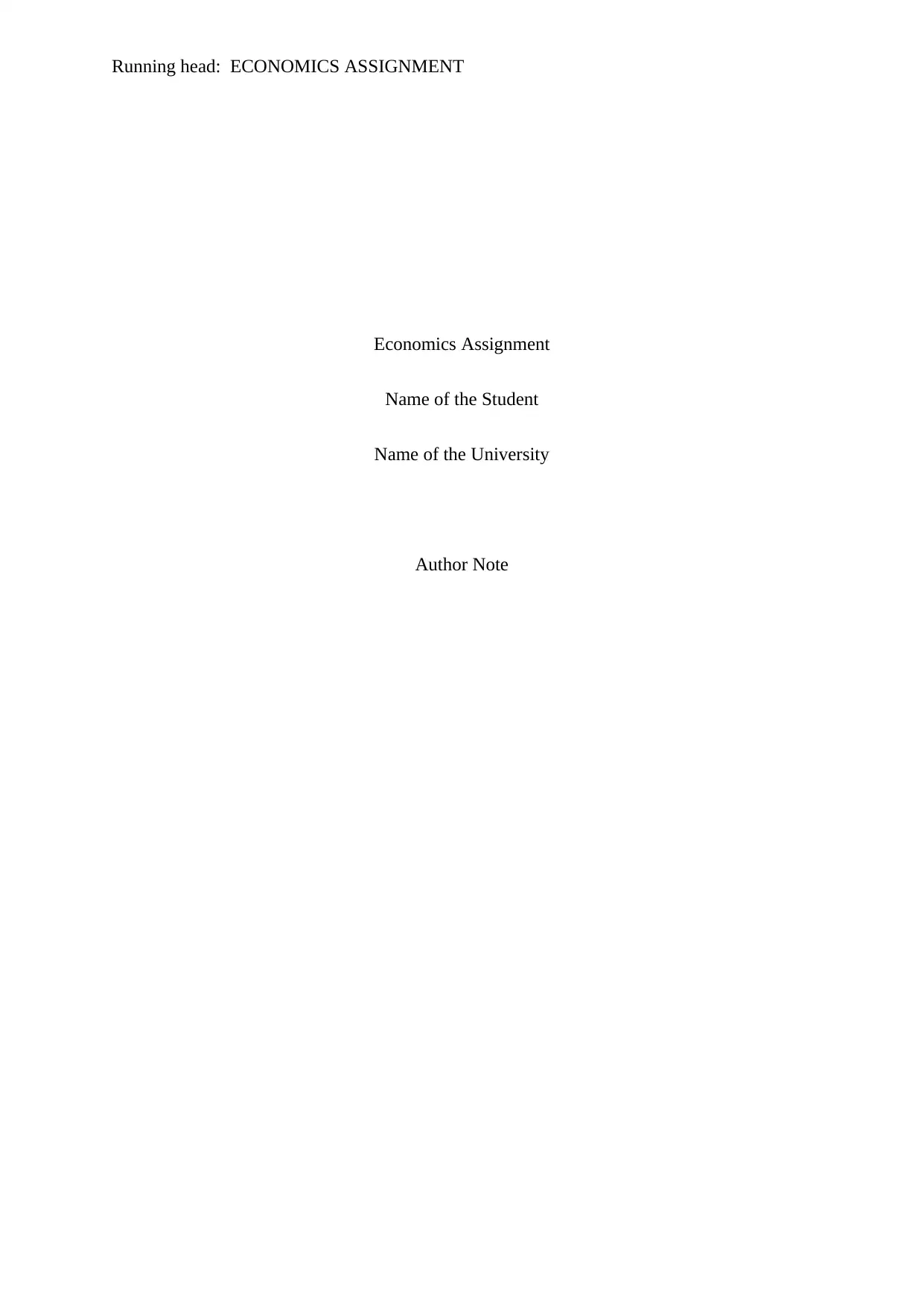
Running head: ECONOMICS ASSIGNMENT
Economics Assignment
Name of the Student
Name of the University
Author Note
Economics Assignment
Name of the Student
Name of the University
Author Note
Secure Best Marks with AI Grader
Need help grading? Try our AI Grader for instant feedback on your assignments.
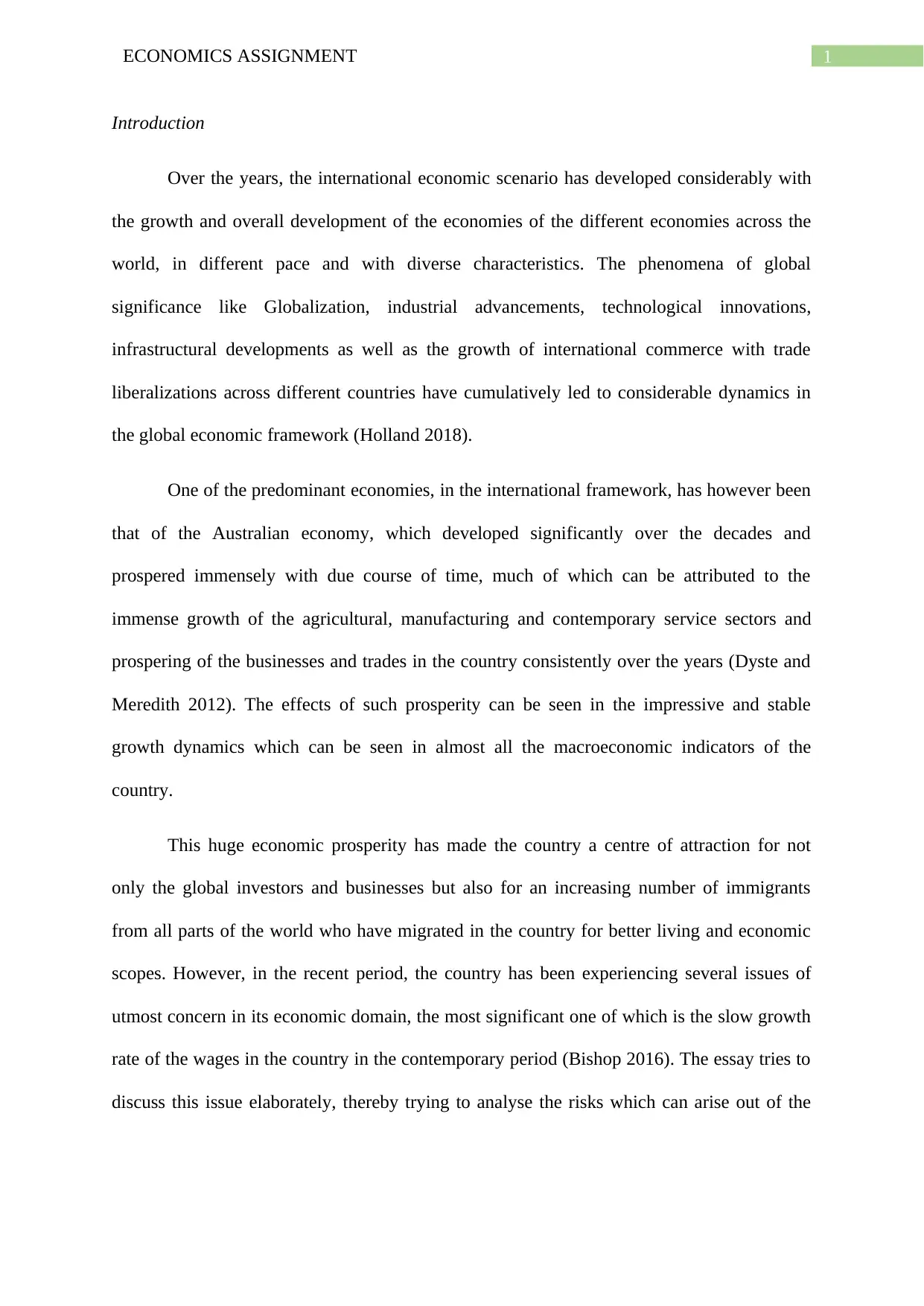
1ECONOMICS ASSIGNMENT
Introduction
Over the years, the international economic scenario has developed considerably with
the growth and overall development of the economies of the different economies across the
world, in different pace and with diverse characteristics. The phenomena of global
significance like Globalization, industrial advancements, technological innovations,
infrastructural developments as well as the growth of international commerce with trade
liberalizations across different countries have cumulatively led to considerable dynamics in
the global economic framework (Holland 2018).
One of the predominant economies, in the international framework, has however been
that of the Australian economy, which developed significantly over the decades and
prospered immensely with due course of time, much of which can be attributed to the
immense growth of the agricultural, manufacturing and contemporary service sectors and
prospering of the businesses and trades in the country consistently over the years (Dyste and
Meredith 2012). The effects of such prosperity can be seen in the impressive and stable
growth dynamics which can be seen in almost all the macroeconomic indicators of the
country.
This huge economic prosperity has made the country a centre of attraction for not
only the global investors and businesses but also for an increasing number of immigrants
from all parts of the world who have migrated in the country for better living and economic
scopes. However, in the recent period, the country has been experiencing several issues of
utmost concern in its economic domain, the most significant one of which is the slow growth
rate of the wages in the country in the contemporary period (Bishop 2016). The essay tries to
discuss this issue elaborately, thereby trying to analyse the risks which can arise out of the
Introduction
Over the years, the international economic scenario has developed considerably with
the growth and overall development of the economies of the different economies across the
world, in different pace and with diverse characteristics. The phenomena of global
significance like Globalization, industrial advancements, technological innovations,
infrastructural developments as well as the growth of international commerce with trade
liberalizations across different countries have cumulatively led to considerable dynamics in
the global economic framework (Holland 2018).
One of the predominant economies, in the international framework, has however been
that of the Australian economy, which developed significantly over the decades and
prospered immensely with due course of time, much of which can be attributed to the
immense growth of the agricultural, manufacturing and contemporary service sectors and
prospering of the businesses and trades in the country consistently over the years (Dyste and
Meredith 2012). The effects of such prosperity can be seen in the impressive and stable
growth dynamics which can be seen in almost all the macroeconomic indicators of the
country.
This huge economic prosperity has made the country a centre of attraction for not
only the global investors and businesses but also for an increasing number of immigrants
from all parts of the world who have migrated in the country for better living and economic
scopes. However, in the recent period, the country has been experiencing several issues of
utmost concern in its economic domain, the most significant one of which is the slow growth
rate of the wages in the country in the contemporary period (Bishop 2016). The essay tries to
discuss this issue elaborately, thereby trying to analyse the risks which can arise out of the
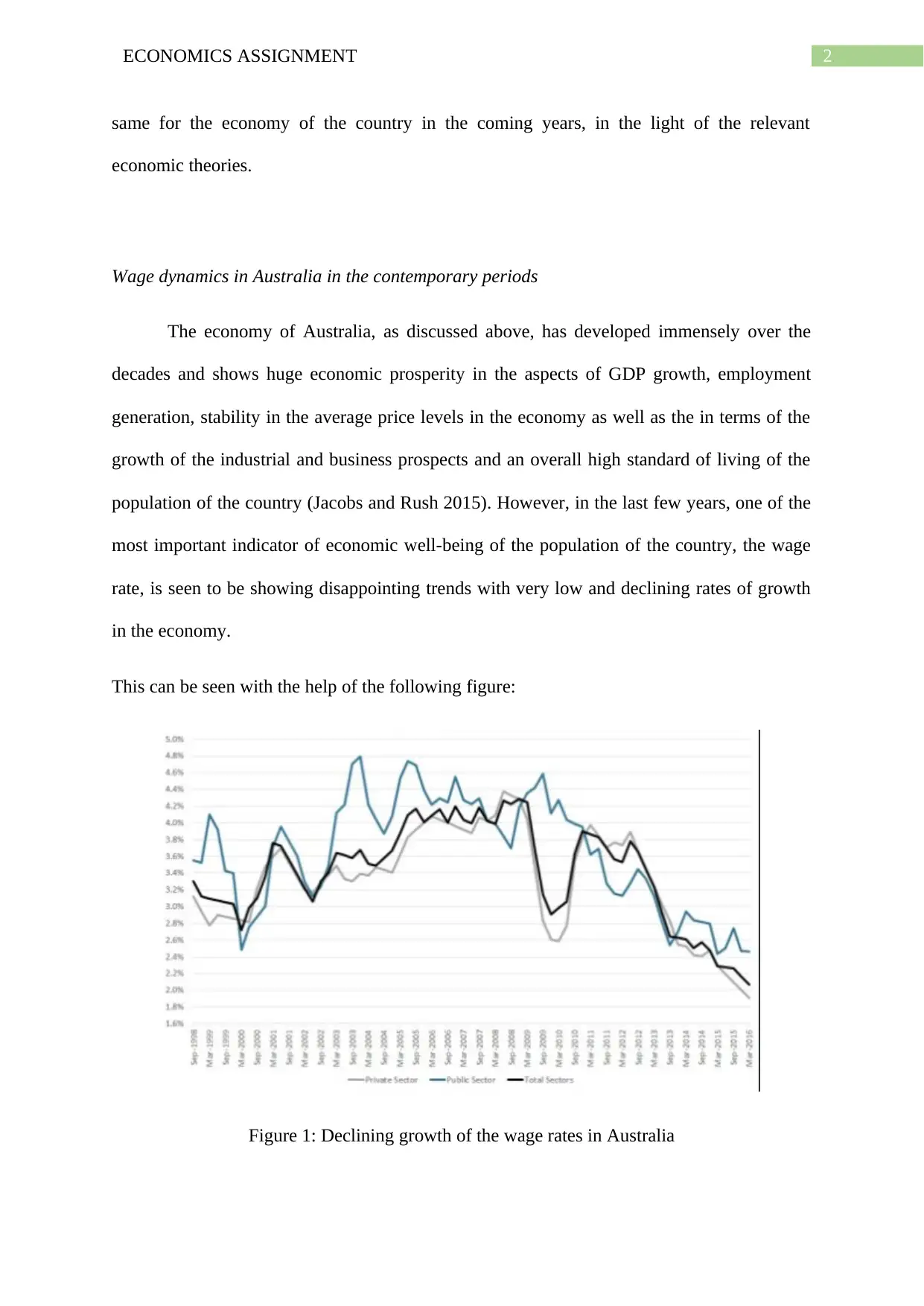
2ECONOMICS ASSIGNMENT
same for the economy of the country in the coming years, in the light of the relevant
economic theories.
Wage dynamics in Australia in the contemporary periods
The economy of Australia, as discussed above, has developed immensely over the
decades and shows huge economic prosperity in the aspects of GDP growth, employment
generation, stability in the average price levels in the economy as well as the in terms of the
growth of the industrial and business prospects and an overall high standard of living of the
population of the country (Jacobs and Rush 2015). However, in the last few years, one of the
most important indicator of economic well-being of the population of the country, the wage
rate, is seen to be showing disappointing trends with very low and declining rates of growth
in the economy.
This can be seen with the help of the following figure:
Figure 1: Declining growth of the wage rates in Australia
same for the economy of the country in the coming years, in the light of the relevant
economic theories.
Wage dynamics in Australia in the contemporary periods
The economy of Australia, as discussed above, has developed immensely over the
decades and shows huge economic prosperity in the aspects of GDP growth, employment
generation, stability in the average price levels in the economy as well as the in terms of the
growth of the industrial and business prospects and an overall high standard of living of the
population of the country (Jacobs and Rush 2015). However, in the last few years, one of the
most important indicator of economic well-being of the population of the country, the wage
rate, is seen to be showing disappointing trends with very low and declining rates of growth
in the economy.
This can be seen with the help of the following figure:
Figure 1: Declining growth of the wage rates in Australia
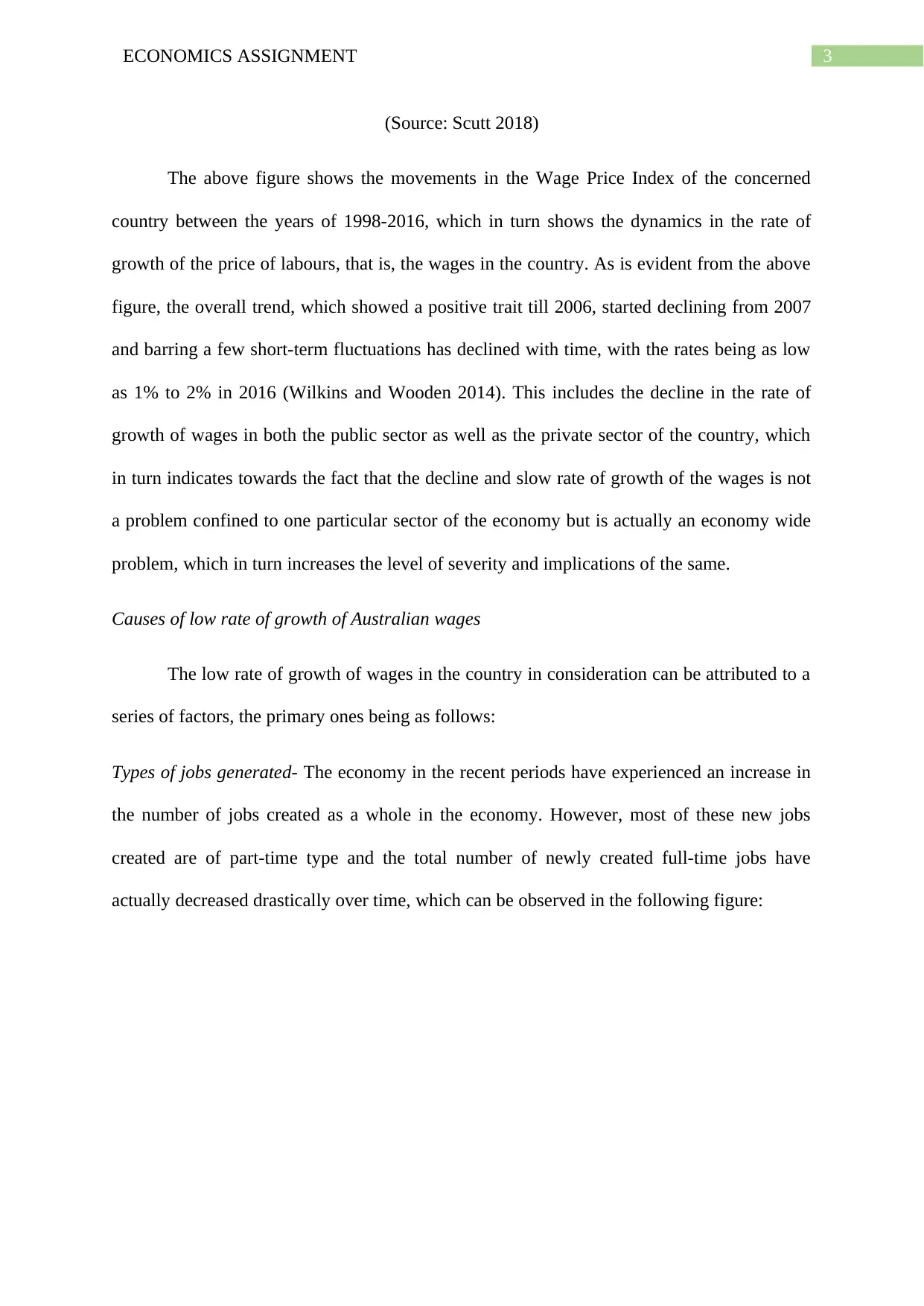
3ECONOMICS ASSIGNMENT
(Source: Scutt 2018)
The above figure shows the movements in the Wage Price Index of the concerned
country between the years of 1998-2016, which in turn shows the dynamics in the rate of
growth of the price of labours, that is, the wages in the country. As is evident from the above
figure, the overall trend, which showed a positive trait till 2006, started declining from 2007
and barring a few short-term fluctuations has declined with time, with the rates being as low
as 1% to 2% in 2016 (Wilkins and Wooden 2014). This includes the decline in the rate of
growth of wages in both the public sector as well as the private sector of the country, which
in turn indicates towards the fact that the decline and slow rate of growth of the wages is not
a problem confined to one particular sector of the economy but is actually an economy wide
problem, which in turn increases the level of severity and implications of the same.
Causes of low rate of growth of Australian wages
The low rate of growth of wages in the country in consideration can be attributed to a
series of factors, the primary ones being as follows:
Types of jobs generated- The economy in the recent periods have experienced an increase in
the number of jobs created as a whole in the economy. However, most of these new jobs
created are of part-time type and the total number of newly created full-time jobs have
actually decreased drastically over time, which can be observed in the following figure:
(Source: Scutt 2018)
The above figure shows the movements in the Wage Price Index of the concerned
country between the years of 1998-2016, which in turn shows the dynamics in the rate of
growth of the price of labours, that is, the wages in the country. As is evident from the above
figure, the overall trend, which showed a positive trait till 2006, started declining from 2007
and barring a few short-term fluctuations has declined with time, with the rates being as low
as 1% to 2% in 2016 (Wilkins and Wooden 2014). This includes the decline in the rate of
growth of wages in both the public sector as well as the private sector of the country, which
in turn indicates towards the fact that the decline and slow rate of growth of the wages is not
a problem confined to one particular sector of the economy but is actually an economy wide
problem, which in turn increases the level of severity and implications of the same.
Causes of low rate of growth of Australian wages
The low rate of growth of wages in the country in consideration can be attributed to a
series of factors, the primary ones being as follows:
Types of jobs generated- The economy in the recent periods have experienced an increase in
the number of jobs created as a whole in the economy. However, most of these new jobs
created are of part-time type and the total number of newly created full-time jobs have
actually decreased drastically over time, which can be observed in the following figure:
Secure Best Marks with AI Grader
Need help grading? Try our AI Grader for instant feedback on your assignments.
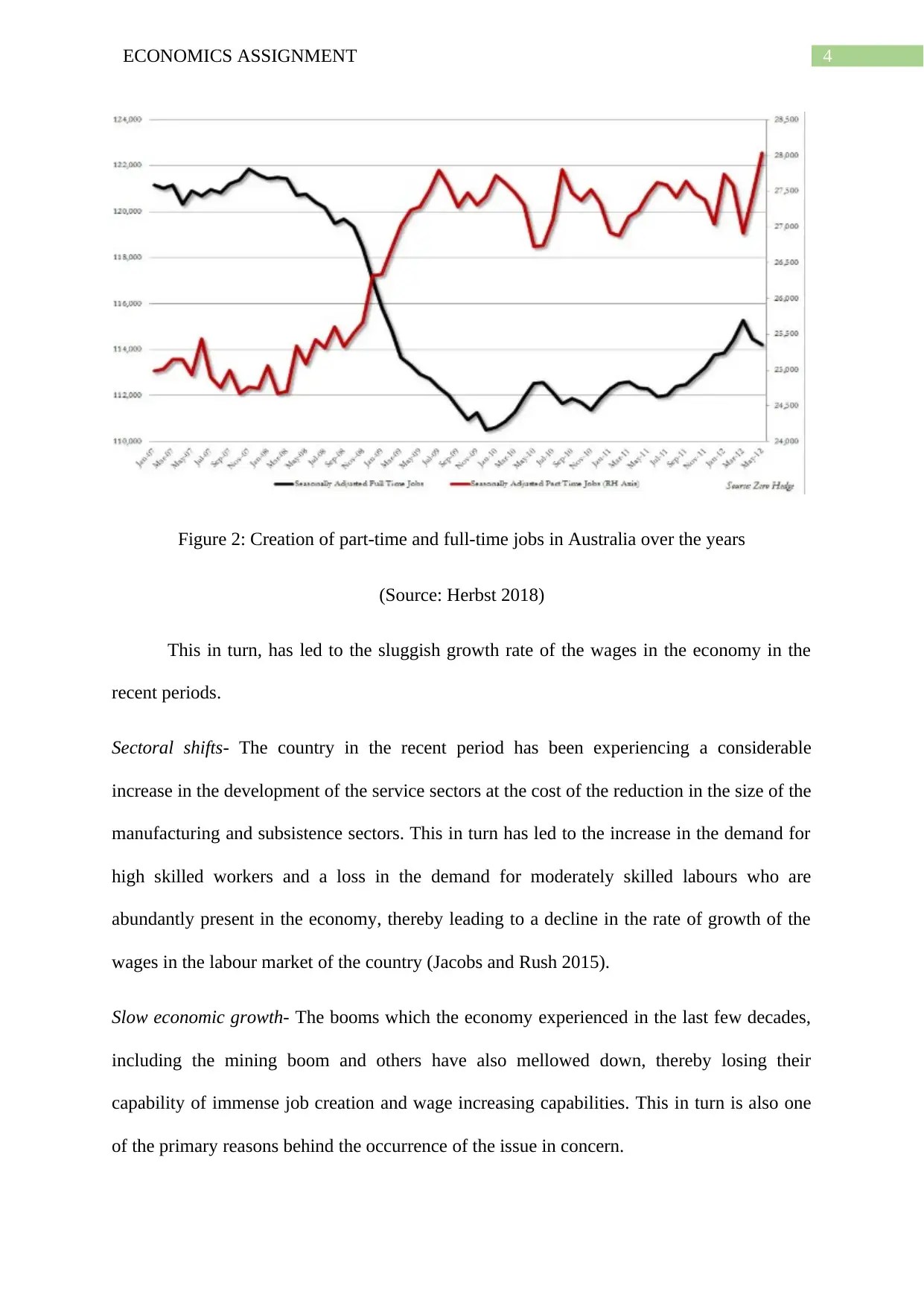
4ECONOMICS ASSIGNMENT
Figure 2: Creation of part-time and full-time jobs in Australia over the years
(Source: Herbst 2018)
This in turn, has led to the sluggish growth rate of the wages in the economy in the
recent periods.
Sectoral shifts- The country in the recent period has been experiencing a considerable
increase in the development of the service sectors at the cost of the reduction in the size of the
manufacturing and subsistence sectors. This in turn has led to the increase in the demand for
high skilled workers and a loss in the demand for moderately skilled labours who are
abundantly present in the economy, thereby leading to a decline in the rate of growth of the
wages in the labour market of the country (Jacobs and Rush 2015).
Slow economic growth- The booms which the economy experienced in the last few decades,
including the mining boom and others have also mellowed down, thereby losing their
capability of immense job creation and wage increasing capabilities. This in turn is also one
of the primary reasons behind the occurrence of the issue in concern.
Figure 2: Creation of part-time and full-time jobs in Australia over the years
(Source: Herbst 2018)
This in turn, has led to the sluggish growth rate of the wages in the economy in the
recent periods.
Sectoral shifts- The country in the recent period has been experiencing a considerable
increase in the development of the service sectors at the cost of the reduction in the size of the
manufacturing and subsistence sectors. This in turn has led to the increase in the demand for
high skilled workers and a loss in the demand for moderately skilled labours who are
abundantly present in the economy, thereby leading to a decline in the rate of growth of the
wages in the labour market of the country (Jacobs and Rush 2015).
Slow economic growth- The booms which the economy experienced in the last few decades,
including the mining boom and others have also mellowed down, thereby losing their
capability of immense job creation and wage increasing capabilities. This in turn is also one
of the primary reasons behind the occurrence of the issue in concern.
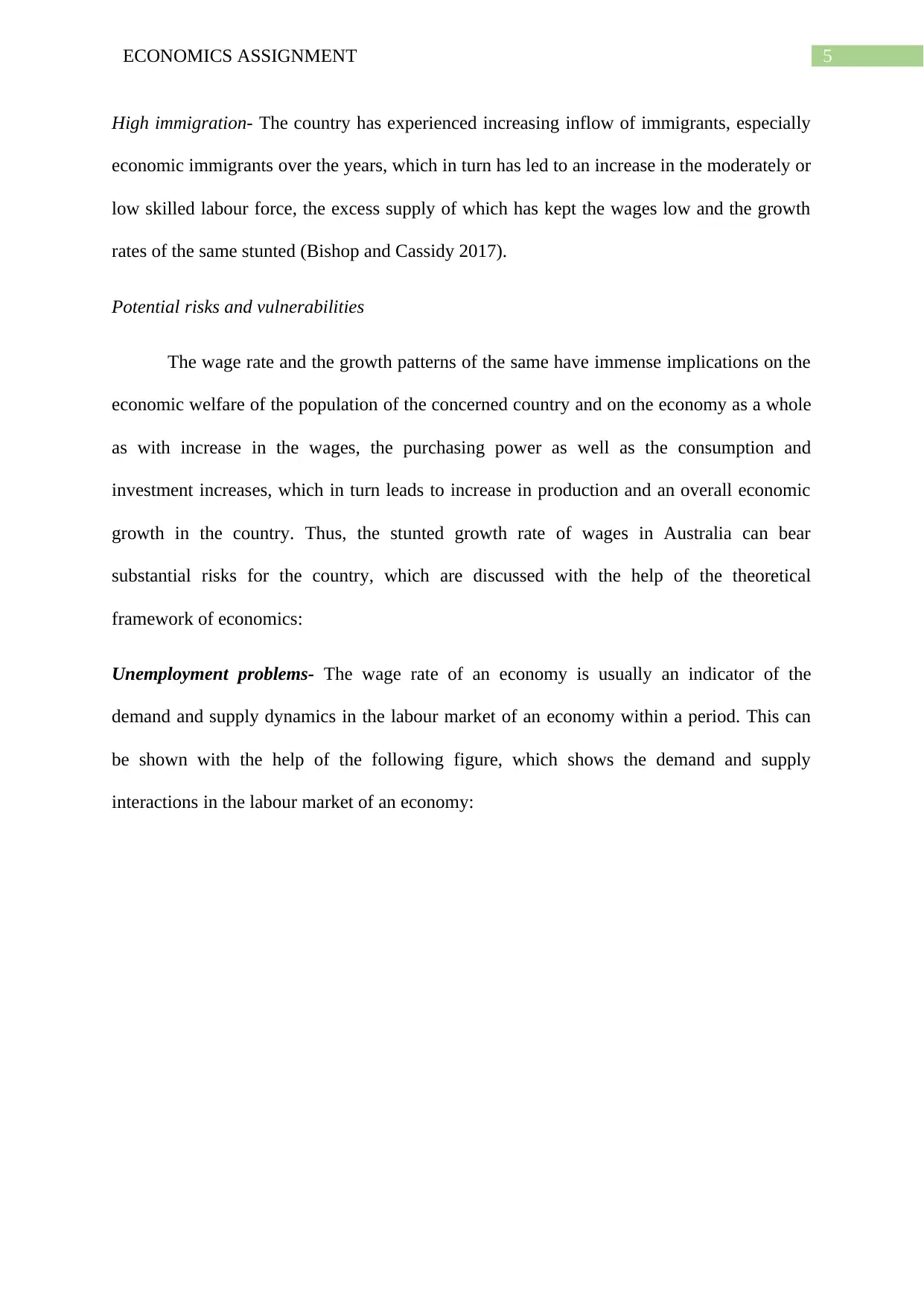
5ECONOMICS ASSIGNMENT
High immigration- The country has experienced increasing inflow of immigrants, especially
economic immigrants over the years, which in turn has led to an increase in the moderately or
low skilled labour force, the excess supply of which has kept the wages low and the growth
rates of the same stunted (Bishop and Cassidy 2017).
Potential risks and vulnerabilities
The wage rate and the growth patterns of the same have immense implications on the
economic welfare of the population of the concerned country and on the economy as a whole
as with increase in the wages, the purchasing power as well as the consumption and
investment increases, which in turn leads to increase in production and an overall economic
growth in the country. Thus, the stunted growth rate of wages in Australia can bear
substantial risks for the country, which are discussed with the help of the theoretical
framework of economics:
Unemployment problems- The wage rate of an economy is usually an indicator of the
demand and supply dynamics in the labour market of an economy within a period. This can
be shown with the help of the following figure, which shows the demand and supply
interactions in the labour market of an economy:
High immigration- The country has experienced increasing inflow of immigrants, especially
economic immigrants over the years, which in turn has led to an increase in the moderately or
low skilled labour force, the excess supply of which has kept the wages low and the growth
rates of the same stunted (Bishop and Cassidy 2017).
Potential risks and vulnerabilities
The wage rate and the growth patterns of the same have immense implications on the
economic welfare of the population of the concerned country and on the economy as a whole
as with increase in the wages, the purchasing power as well as the consumption and
investment increases, which in turn leads to increase in production and an overall economic
growth in the country. Thus, the stunted growth rate of wages in Australia can bear
substantial risks for the country, which are discussed with the help of the theoretical
framework of economics:
Unemployment problems- The wage rate of an economy is usually an indicator of the
demand and supply dynamics in the labour market of an economy within a period. This can
be shown with the help of the following figure, which shows the demand and supply
interactions in the labour market of an economy:

6ECONOMICS ASSIGNMENT
W
W
W0
W1
0 L Labour
Labour Supply
Demand for Labour
Excess Supply of Labour
Excess demand for labour
Figure 3: Demand and supply interactions in the labour market
(Source: As created by the author)
As can be seen from the above the equilibrium wage occurs at the point in the labour
market of an economy where the supply of labour matches with the demand for the same
(Healy 2016). When there is an excess supply of labour, people are forced to work in lower
wages, thereby lowering the wage down for the economy and vice versa.
In case of Australia, this can be found to be relevant. The persisting low growth rates
of the wages in the economy over the last few years indicates towards the fact that the
country is possibly at the risk of low employment generation and high unemployment of
especially the majority share of the labours, who are moderately skilled, which can be
attributed to the increasing shift of the economy to the capital-intensive capital sectors from
the labour-intensive manufacturing and agricultural sectors (Corden 2012).
W
W
W0
W1
0 L Labour
Labour Supply
Demand for Labour
Excess Supply of Labour
Excess demand for labour
Figure 3: Demand and supply interactions in the labour market
(Source: As created by the author)
As can be seen from the above the equilibrium wage occurs at the point in the labour
market of an economy where the supply of labour matches with the demand for the same
(Healy 2016). When there is an excess supply of labour, people are forced to work in lower
wages, thereby lowering the wage down for the economy and vice versa.
In case of Australia, this can be found to be relevant. The persisting low growth rates
of the wages in the economy over the last few years indicates towards the fact that the
country is possibly at the risk of low employment generation and high unemployment of
especially the majority share of the labours, who are moderately skilled, which can be
attributed to the increasing shift of the economy to the capital-intensive capital sectors from
the labour-intensive manufacturing and agricultural sectors (Corden 2012).
Paraphrase This Document
Need a fresh take? Get an instant paraphrase of this document with our AI Paraphraser
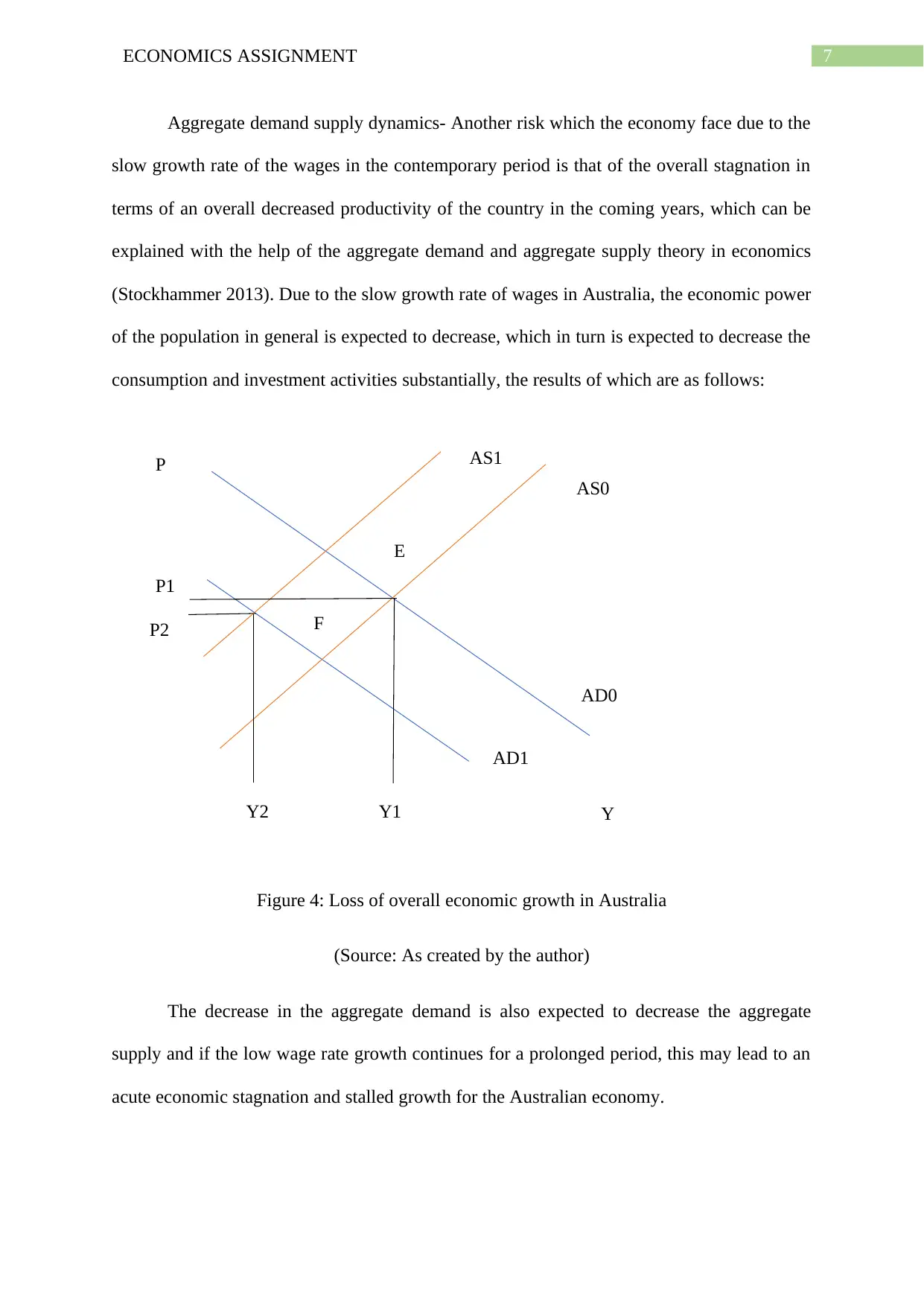
7ECONOMICS ASSIGNMENT
P
P1
P2
Y2 Y1 Y
AS1
AS0
AD1
AD0
F
E
Aggregate demand supply dynamics- Another risk which the economy face due to the
slow growth rate of the wages in the contemporary period is that of the overall stagnation in
terms of an overall decreased productivity of the country in the coming years, which can be
explained with the help of the aggregate demand and aggregate supply theory in economics
(Stockhammer 2013). Due to the slow growth rate of wages in Australia, the economic power
of the population in general is expected to decrease, which in turn is expected to decrease the
consumption and investment activities substantially, the results of which are as follows:
Figure 4: Loss of overall economic growth in Australia
(Source: As created by the author)
The decrease in the aggregate demand is also expected to decrease the aggregate
supply and if the low wage rate growth continues for a prolonged period, this may lead to an
acute economic stagnation and stalled growth for the Australian economy.
P
P1
P2
Y2 Y1 Y
AS1
AS0
AD1
AD0
F
E
Aggregate demand supply dynamics- Another risk which the economy face due to the
slow growth rate of the wages in the contemporary period is that of the overall stagnation in
terms of an overall decreased productivity of the country in the coming years, which can be
explained with the help of the aggregate demand and aggregate supply theory in economics
(Stockhammer 2013). Due to the slow growth rate of wages in Australia, the economic power
of the population in general is expected to decrease, which in turn is expected to decrease the
consumption and investment activities substantially, the results of which are as follows:
Figure 4: Loss of overall economic growth in Australia
(Source: As created by the author)
The decrease in the aggregate demand is also expected to decrease the aggregate
supply and if the low wage rate growth continues for a prolonged period, this may lead to an
acute economic stagnation and stalled growth for the Australian economy.

8ECONOMICS ASSIGNMENT
P
P1
P2
0 Y2 Y1 Y
E1
E0
Aggregate Supply
Negative Inflation- Like high inflation, an acutely low inflation can also be adversely
affecting the economy, as shown in the following figure:
Figure 5: Fall in aggregate supply due to fall in price levels
(Source: As created by the author)
As fall in the price of commodities and services would lead to the fall in the supply of
the same in the country as a whole, thereby creating more unemployment and economic
downturn, which may continue like a viscous cycle (Kumar, Webber and Perry 2012).
Conclusion
From the above discussion it can be seen that the economy of Australia, experiencing
the concerning problem of a sluggish and disappointing growth rate of the wages in the
contemporary period, faces the probable risks of an overall economic stagnation caused by
the lack of employment generation, lack of aggregate demand and supply as well as an
overall loss of productivity in the country in the coming years, provided the problem of low
P
P1
P2
0 Y2 Y1 Y
E1
E0
Aggregate Supply
Negative Inflation- Like high inflation, an acutely low inflation can also be adversely
affecting the economy, as shown in the following figure:
Figure 5: Fall in aggregate supply due to fall in price levels
(Source: As created by the author)
As fall in the price of commodities and services would lead to the fall in the supply of
the same in the country as a whole, thereby creating more unemployment and economic
downturn, which may continue like a viscous cycle (Kumar, Webber and Perry 2012).
Conclusion
From the above discussion it can be seen that the economy of Australia, experiencing
the concerning problem of a sluggish and disappointing growth rate of the wages in the
contemporary period, faces the probable risks of an overall economic stagnation caused by
the lack of employment generation, lack of aggregate demand and supply as well as an
overall loss of productivity in the country in the coming years, provided the problem of low
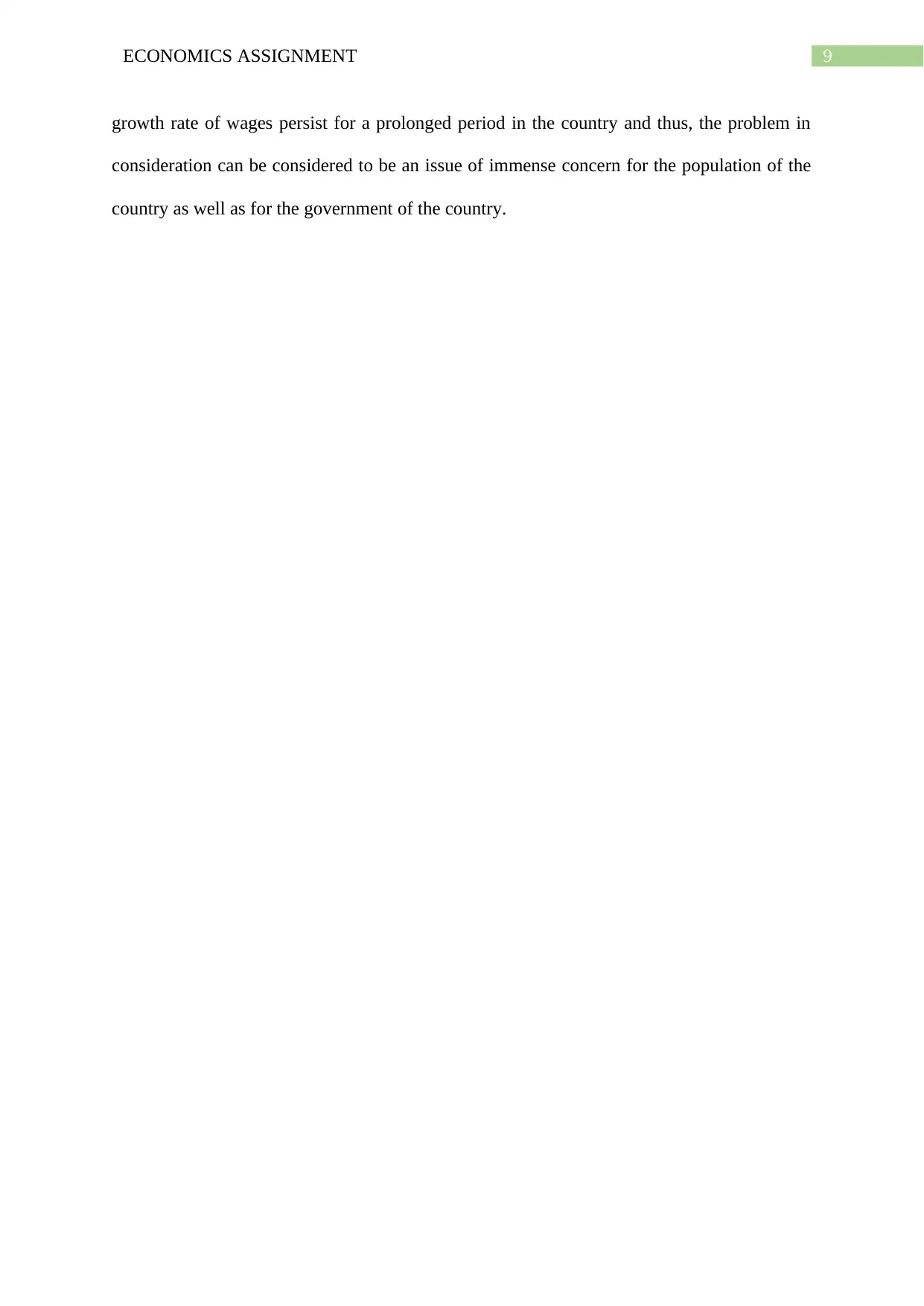
9ECONOMICS ASSIGNMENT
growth rate of wages persist for a prolonged period in the country and thus, the problem in
consideration can be considered to be an issue of immense concern for the population of the
country as well as for the government of the country.
growth rate of wages persist for a prolonged period in the country and thus, the problem in
consideration can be considered to be an issue of immense concern for the population of the
country as well as for the government of the country.
Secure Best Marks with AI Grader
Need help grading? Try our AI Grader for instant feedback on your assignments.
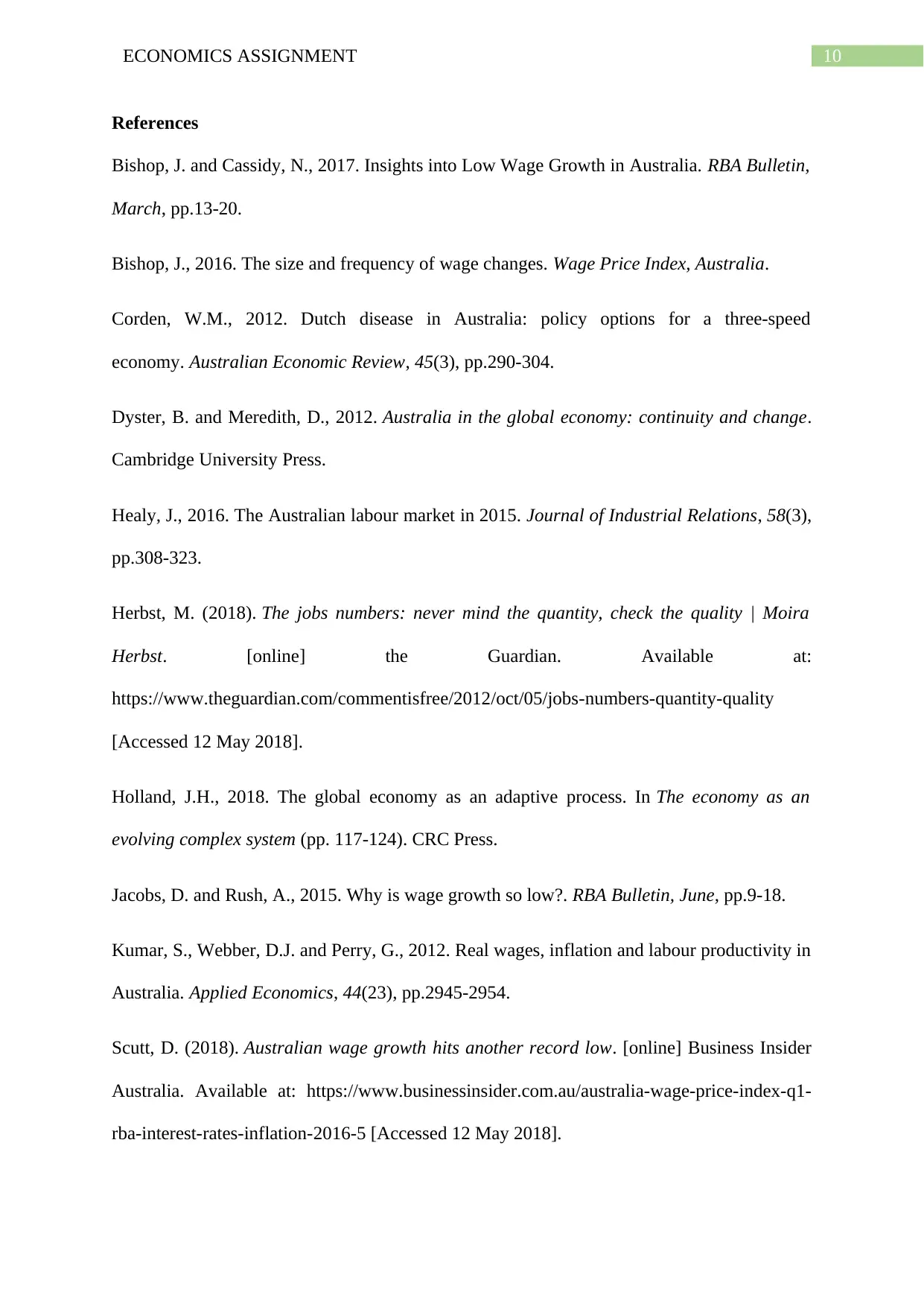
10ECONOMICS ASSIGNMENT
References
Bishop, J. and Cassidy, N., 2017. Insights into Low Wage Growth in Australia. RBA Bulletin,
March, pp.13-20.
Bishop, J., 2016. The size and frequency of wage changes. Wage Price Index, Australia.
Corden, W.M., 2012. Dutch disease in Australia: policy options for a three‐speed
economy. Australian Economic Review, 45(3), pp.290-304.
Dyster, B. and Meredith, D., 2012. Australia in the global economy: continuity and change.
Cambridge University Press.
Healy, J., 2016. The Australian labour market in 2015. Journal of Industrial Relations, 58(3),
pp.308-323.
Herbst, M. (2018). The jobs numbers: never mind the quantity, check the quality | Moira
Herbst. [online] the Guardian. Available at:
https://www.theguardian.com/commentisfree/2012/oct/05/jobs-numbers-quantity-quality
[Accessed 12 May 2018].
Holland, J.H., 2018. The global economy as an adaptive process. In The economy as an
evolving complex system (pp. 117-124). CRC Press.
Jacobs, D. and Rush, A., 2015. Why is wage growth so low?. RBA Bulletin, June, pp.9-18.
Kumar, S., Webber, D.J. and Perry, G., 2012. Real wages, inflation and labour productivity in
Australia. Applied Economics, 44(23), pp.2945-2954.
Scutt, D. (2018). Australian wage growth hits another record low. [online] Business Insider
Australia. Available at: https://www.businessinsider.com.au/australia-wage-price-index-q1-
rba-interest-rates-inflation-2016-5 [Accessed 12 May 2018].
References
Bishop, J. and Cassidy, N., 2017. Insights into Low Wage Growth in Australia. RBA Bulletin,
March, pp.13-20.
Bishop, J., 2016. The size and frequency of wage changes. Wage Price Index, Australia.
Corden, W.M., 2012. Dutch disease in Australia: policy options for a three‐speed
economy. Australian Economic Review, 45(3), pp.290-304.
Dyster, B. and Meredith, D., 2012. Australia in the global economy: continuity and change.
Cambridge University Press.
Healy, J., 2016. The Australian labour market in 2015. Journal of Industrial Relations, 58(3),
pp.308-323.
Herbst, M. (2018). The jobs numbers: never mind the quantity, check the quality | Moira
Herbst. [online] the Guardian. Available at:
https://www.theguardian.com/commentisfree/2012/oct/05/jobs-numbers-quantity-quality
[Accessed 12 May 2018].
Holland, J.H., 2018. The global economy as an adaptive process. In The economy as an
evolving complex system (pp. 117-124). CRC Press.
Jacobs, D. and Rush, A., 2015. Why is wage growth so low?. RBA Bulletin, June, pp.9-18.
Kumar, S., Webber, D.J. and Perry, G., 2012. Real wages, inflation and labour productivity in
Australia. Applied Economics, 44(23), pp.2945-2954.
Scutt, D. (2018). Australian wage growth hits another record low. [online] Business Insider
Australia. Available at: https://www.businessinsider.com.au/australia-wage-price-index-q1-
rba-interest-rates-inflation-2016-5 [Accessed 12 May 2018].
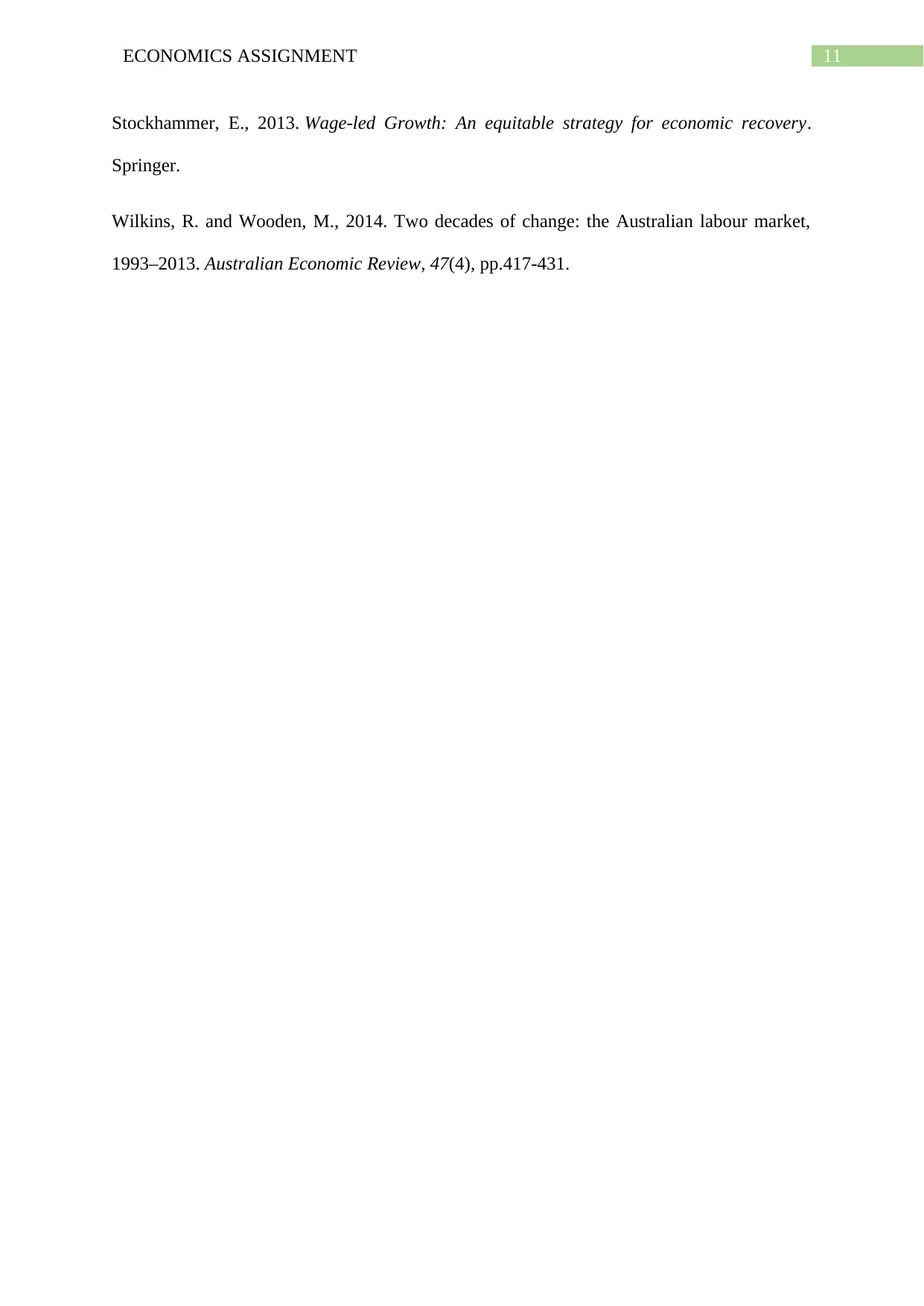
11ECONOMICS ASSIGNMENT
Stockhammer, E., 2013. Wage-led Growth: An equitable strategy for economic recovery.
Springer.
Wilkins, R. and Wooden, M., 2014. Two decades of change: the Australian labour market,
1993–2013. Australian Economic Review, 47(4), pp.417-431.
Stockhammer, E., 2013. Wage-led Growth: An equitable strategy for economic recovery.
Springer.
Wilkins, R. and Wooden, M., 2014. Two decades of change: the Australian labour market,
1993–2013. Australian Economic Review, 47(4), pp.417-431.
1 out of 12
Related Documents
Your All-in-One AI-Powered Toolkit for Academic Success.
+13062052269
info@desklib.com
Available 24*7 on WhatsApp / Email
![[object Object]](/_next/static/media/star-bottom.7253800d.svg)
Unlock your academic potential
© 2024 | Zucol Services PVT LTD | All rights reserved.




